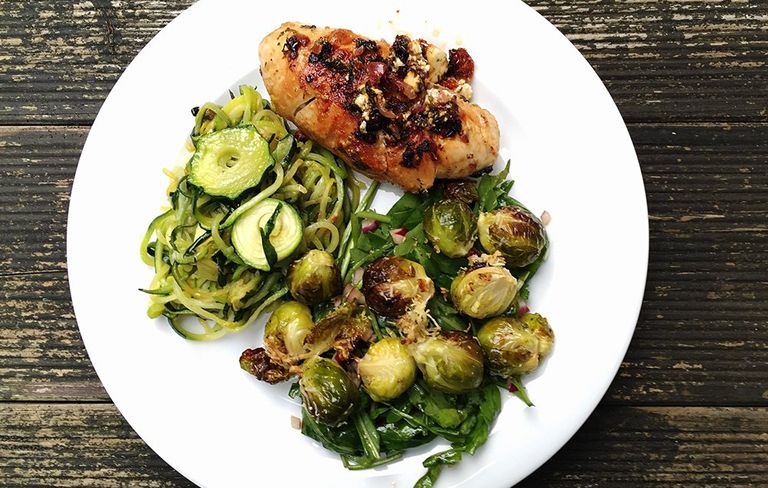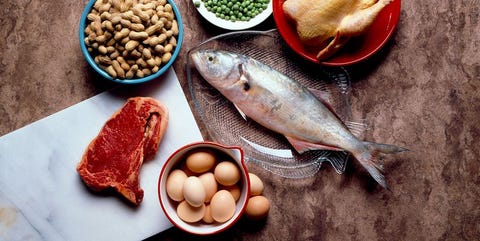
Let’s face it: dieting is hard. But if you believe proponents of the If it Fits Your Macros (or IIFYM) eating plan (also known as “flexible dieting”), you can eat anything you want and still lose weight — without counting calories. All you have to do is count your macros.
According to the IIFYM eating plan, if you stick to your daily macro goals, you’ll automatically consume fewer calories, thus helping you lose weight.
“The overall concept is similar to Weight Watchers in that you can eat what you want as long as you’re keeping your calories at a certain level, but with flexible dieting there’s an emphasis on protein,” explains Brad Schoenfeld, Ph.D., director of the Human Performance Lab at CUNY Lehman College in New York.
Intrigued? Here’s everything you should know about how to count your macros, and whether or not it actually works for weight loss.
First of all, what’s a macro?
Getty Images
There are three macronutrients that make up every bite of food you eat: protein, carbohydrates, and fat. While many foods contain all of these macronutrients, most skew heavily toward one or two of them. For instance, meat is loaded with protein, bread is mostly carbohydrates, and olive oil is predominantly fat. Your body needs all three in some capacity to function.
According to the IIFYM plan, you can lose weight by setting a goal for exactly how many grams of protein, carbohydrates, and fat to eat per day. Unlike most traditional diets, you don’t have to count calories, and unlike low-carb or low-fat diets, you don’t need to to eliminate your favorite foods, like potatoes, pasta, or bacon. In theory, you can eat anything you want under the IIFYM plan, provided it fits into your macro count.
How Do You Find Out How Many Macros You Need?
Calculating your macros requires some basic math. If you’d rather not take the DIY approach, IIFYM.com offers a macro calculator using your current weight, goal weight and activity level.
Step 1: Find out your “energy balance,” or the number of calories you take in and burn each day, Schoenfeld says. The National Institute of Health (NIH) offers an online calculator that uses your weight, activity level, and gender to estimate how many calories your body expends each day. Websites and apps like My Fitness Pal can help you log your calorie intake.
Step 2: Once you have those figures, you need to come up with a target calorie intake to meet your weight goals. To lose weight, you need the number of calories you consume to be 10 to 15 percent below what you’re burning every day, Schoenfeld says.
Step 3: After determining the total number of calories you should eat per day, you’ll have to figure out how many of your daily calories should come from fat, carbs, and protein. Some IIFYM sites and blogs advocate for a strict 40% protein, 40% carbohydrate, and 20% fat split, but Schoenfeld says “there is no optimal ratio. Some people do well on lower-carb plans, and some people do well on lower-fat. It all depends on the individual.”
That said, you should keep an especially close eye on your protein intake: “the scientific literature is very clear that getting proper amounts of protein is the most important thing to maximize muscle and improve body composition,” he says. Some macro diet coaches even advise eating one gram of protein for every pound that you weigh.
If you’re an athlete or in training, your diet should weigh more heavily towards carbohydrates, says Stella Volpe, Ph.D., chair of nutrition sciences at Drexel University in Philadelphia. “You need to replenish that glycogen your muscles are using during exercise,” she explains, since glycogen is the energy that powers you during a workout.
And if you constantly feel hungry, emphasizing healthy fats, like avocados and nuts, may be beneficial. “Fats are very satiating,” Volpe says.
As an example, if your daily calorie goal was 2000, this is what your macronutrient breakdown would look like based on the 40/40/20 ratio noted above.
2000 calories per day x .40 (percentage of calories from carbs) = 800 calories➗ 4 (the number of calories per gram of carbohydrate) = 200 grams of carbohydrates
2000 calories per day x .40 (percentage of calories from protein) = 800 calories➗ 4 (the number of calories per gram of protein) = 200 grams of protein
2000 calories per day x .20 (percentage of calories from protein) = 400 calories ➗ 9 (the number of calories per gram of fat)= 44 grams of fat
Does counting your macros help you lose weight?
Some nutritional experts are fans of flexible dieting because it doesn’t restrict foods and offers more wiggle room for occasional indulgences.
“I think focusing on the right balance of protein and carbs and fat while allowing yourself some freedom to eat candy or fun foods now and then is a good approach,” says Volpe.
That said, flexible dieting is not an excuse to eat whatever you want. Food quality still matters. Vegetables, which are full of disease-fighting antioxidants and fiber, will always be better for you than chips or cookies, which are essentially empty calories.
“I’m a proponent of flexible dieting, and I think it’s the most practical approach to weight maintenance, but I think the concept has been bastardized a little bit,” Schoenfeld says. “Some people have oversimplified it and said you can eat Pop Tarts or Cheez Doodles for your carbohydrates as long as you’re hitting your macros, and I don’t agree with that.”
Consistently eating large amounts of fast food and processed snacks just because it “fits your macros” isn’t necessarily sustainable when you look at the bigger picture of what it means to eat for your health. “The quality of your diet is still one of the most important factors,” says Volpe.
How Do I Get Started?
After you calculate your macros, staying within your daily goals can be difficult if you’re not doing a little meal prep, according to registered dietitian Lauren Kelly.
“Planning ahead is always a good idea—this way, you can feel confident that you will more easily reach your goals for the day,” she explained to Cooking Light.
Investing in a food scale to weigh meals is also helpful to ensure you’re not overeating, as it’s easy to underestimate portion sizes. The Escali Primo Digital Kitchen Scale costs less than $30 on Amazon and has more than 1,000 reviews.
Now, this all may sound like a lot of work, but it doesn’t have to be. In fact, next to diets that eliminate whole food groups or prescribe complicated and specific food combinations, IIFYM can seem more relaxed in comparison.
“Adherence is the most important thing for any diet to be successful, and we know people don’t stick with these restrictive diets,” Schoenfeld says. “Flexible diets allow you to lose weight or have success while eating a much wider range of foods.”
Source: Read Full Article
